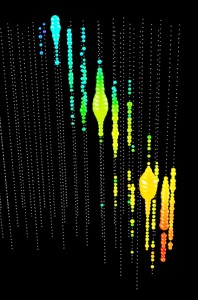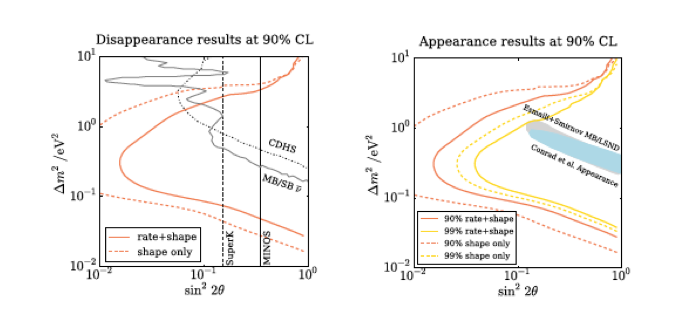The IceCube neutrino observatory is a 1 gigaton Cherenkov detector using Antarctic ice as a detection medium for high energy atmospheric and astrophysical neutrinos. The experiment is located at the South Pole, right in the middle of the map above. (Just for fun, this map shows the winds -- it is pretty tough down for the IceCube collaborators that go down there!) The official webpage for IceCube is here, and includes the latest weekly report from the pole!

Proposed as a telescope for neutrino astronomy, deployment of IceCube optical modules into the ice began in 2005. The last of the 5160 digital optical modules (DOMs) which make up the 86-string IceCube detector, were deployed in late 2010. The above event display is of a neutrino event that occurred in the ice, sending a muon upward through the detector. IceCube is now running in this configuration and has discovered exciting astrophysical neutrino events.

We joined IceCube because the detector can also be used for particle physics studies that are well-aligned with out interests. Our first analysis, performed jointly with the University of Wisconsin IceCube Collaborators, was a sterile neutrino search. The signature of a sterile neutrino in IceCube is a resonant depletion of up-going muon neutrinos in the TeV energy range, caused by matter effects as the neutrino propagates through the Earth. The resonance will occur at a specific energy and zenith angle which depends on the oscillation parameters. You can learn all about this in Ben Jones' thesis here. The result was submitted to PRL and is now a TOPCIT 100+: arXiv:1605.01990. The plots above show the final result. We are following this up! We have an analysis with more than an order of magnitude more statistics. This will be Spencer Axani's thesis result.
We do many other Beyond Standard Model Searches. For example, we have also performed a very precise search for Lorentz Violation. Our work on this is described in our blog for the Journal Nature. Our Nature Physics paper is available on arXiv: arXiv:1709.03434.
Here are some other recent IceCube and IceCube-related papers written by members of our group:
- "Imaging Galactic Dark Matter with High-Energy Cosmic Neutrinos," arXiv:1703.00451. Phys.Rev.Lett. 119, no. 20,201801, 2017.
- "Search for Non-Standard Neutrino Interactions with IceCube-DeepCore," arXiv:1709.07079. Phys.Rev.D 97, no. 7, 072009, 2018.
- "Solar Atmospheric Neutrinos and the Sensitivity Floor for Solar Dark Matter Annihilation Searches," arXiv:1703.0779.8 JCAP 1707, no. 07, 024, 2017.
- "High-energy neutrino attenuation in the Earth and its associated uncertainties," arXiv:1706.09895. JCAP 1711, no. 11, 012, 2017.
We have developed a small muon detector for use in IceCube's upgrade, GEN2. The prototype of this grew into the CosmicWatch $100 Desktop Muon Counter. Please check the website and also our articles about CosmicWatch!
- "The Desktop Muon Detector: A simple, physics-motivated machine- and electronics-shop project for university students," arXiv:1606.01196. American Journal of Physics, 85, 948, 2017.
- "The CosmicWatch Desktop Muon Detector: a self-contained, pocket sized particle detector," arXiv:1801.03029. JINST 13, no. 03, P03019, 2018.
